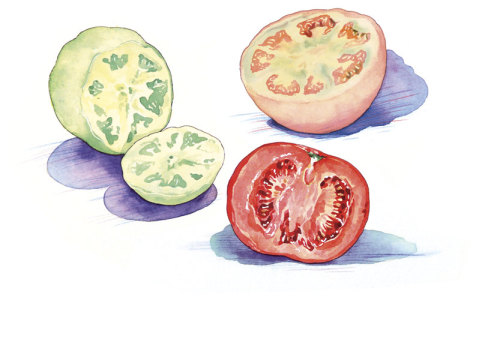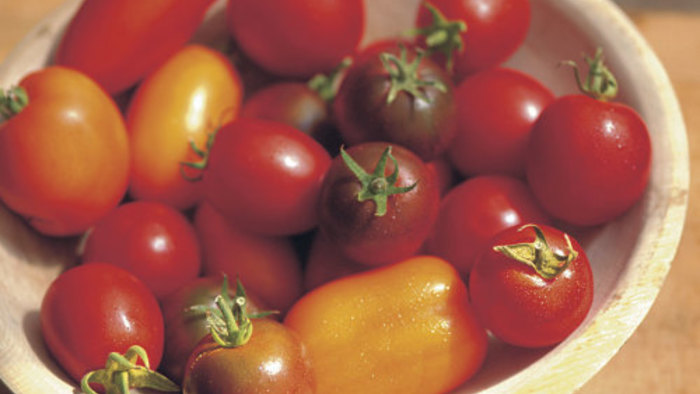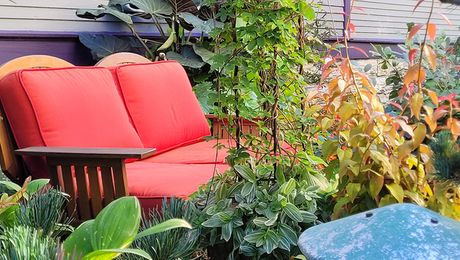
by Israel Zelitch
February 1999
from issue #19
The reason homegrown tomatoes taste and smell so good compared to their shipped-in brethren is simple: Horticultural scientists haven’t figured out how to duplicate the natural chemistry of the garden. Until they do, the best tomatoes will continue to come from your own kitchen garden. But how does it happen? How does a pale-green, hard ball become a mouth-watering red delicacy? Desirable tomato characteristics result from a careful biochemical choreography.
Everything begins with ethylene. The role this gas plays as a biochemical director behind the scenes was proven scientifically when plant physiologists produced a mutant tomato that was unable to create its own ethylene. The green fruit failed to ripen in the usual way.
Ethylene, which comes from an amino acid called methonine, triggers in the fruit a cascade of changes that move the ripening process forward. Among those changes is the creation of more ethylene. The fruit turns color. Sugars and organic acids form, along with the volatile compounds that account for the aroma. And there is an increase of an enzyme called polygalacturonase that breaks down cell walls and softens the fruit. All these changes in the developing fruit ultimately create good appearance, flavor, and texture.
How green fruit turns red
Ripening begins quite suddenly 60 to 90 days after seedlings have been transplanted, depending on the cultivar. The plant has its own self-interest at stake in this process. Ripening is a step toward the collapse of the fruit and the distribution of seeds for the next generation.
The first sign of ripening we see is a blush on the tomato’s face. The reddening of the fruit begins when ethylene signals the chlorophyll-containing chloroplasts that they won’t be needed anymore. The green pigment breaks down as the chloroplasts turn into structures called chromoplasts, which are about five times larger than chloroplasts.
The chromoplasts take on new pigments, which are carotenoids that give the tomato its red color. The carotenoid lycopene, which is red, makes up 90 percent of the carotenoid in a deep red tomato. Most of the remainder is beta-carotene, which is yellow-orange. As the proportion of beta-carotene increases, fruits become more orange. This can be controlled genetically, which is why we have orange and yellow tomato varieties.
In one study, temperature played a role. At higher temperatures, above 86˚F, lycopene synthesis was inhibited in one cultivar, and normally red tomatoes became orange. But beta-carotene synthesis was not blocked by high temperatures.
Light is not essential for the development of tomato chromoplasts and tomato color, but in some experiments fruits had up to 100 percent more carotenoid when ripened in light compared to darkness.
Don’t go by color alone
Gardeners usually must pace and wait for about three weeks for a tomato to go from a full-size green fruit to a completely ripe one. Color provides a good indicator of when to harvest. But, by itself, color intensity is not always related to good tomato taste, since softness and other more subtly controlled factors are involved in ripening.
Take sweetness, for example. Full-size green tomatoes are starchy. The starch disappears as they ripen, and the concentration of sugars, including super-sweet fructose, increases. The sugars in tomato fruits are synthesized in the plant’s leaves and are transported to the fruits. Interference with leaf photosynthesis, which can result from disease-damaged leaves, a drought, or a long spell of cloudy days, will reduce sweetness. The more sunlight, the better.
This means that while a fruit may go on turning red, it may not necessarily have developed proper sweetness. And once a fruit is removed from the vine, its supply of sugars is cut off.
A balance of sugars and acids results in good flavor
As the fruit takes in oxygen, some of the sugars are converted into malic acid, which also flavors apples, and citric acid, familiar to orange eaters. These organic acids accumulate and are stored during ripening, and supply the tartness in the ripe tomato. The concentrations of sugars and acids increase during ripening, but the sugars increase to a greater degree, leaving more sugar than acid in the typical ripe tomato.
These compounds, when properly balanced, provide some, but not all, of the preferred tomato taste. Other important components of tomato flavor are the volatile compounds that create the wonderful aroma of summer tomatoes.
Chemists have analyzed the aroma released by ripe tomatoes, and a number of compounds were correlated with good flavor. Some of these compounds showed significant differences among cultivars grown in the same environment.
The major chemical contributing to tomato-like aroma is a compound called hexenal, which is slightly volatile. In a class of compounds called aldehydes, hexenal has chemical similarities to formaldehyde, but it is not toxic. It is produced within the fruit tissues, mainly at the fully ripe stage. An experiment showed significant changes in hexenal levels in ripe tomatoes harvested on different dates during the season. This research by scientists at the U.S. Department of Agriculture suggests that weather can influence hexenal formation. At low and high temperatures, the levels of flavor-inducing volatile compounds were reduced, with the higher temperatures doing more damage.
Thus, for optimum tomato taste, a proper coordination and balance must be achieved among individual aroma compounds, sugars, and acids, in addition to softening of the cell walls. To enjoy the crescendo of flavor found during the few peak days of maturity, gardeners must make the effort to grow healthy tomato plants and try different cultivars to find those that are well adapted to their particular environment.
Storing partly ripe tomatoes
In the off-season, fruits for distant markets are harvested at the mature green stage. Producers place them in closed storage for two days at 70˚F and add ethylene, which mimics ripening on the vine. But the tomato’s own complex procedures cannot be reproduced. It is too much to expect that a green tomato shipped thousands of miles will be as good as fruit harvested from the vine in summer.
But sometimes gardeners must pick firm green fruits to save them from frost, pests, or disease. Fruits can be wrapped in newspaper, or put in a container with a ripening apple or banana to increase the ethylene level. Ethylene will do its job of softening the tomato by increasing the polygalacturonase. This happens whether the fruit is in a bag or on the vine. But there’s no way to replace
the supply of sugars.
Light is not essential for ripening tomatoes indoors. Indeed, direct sunlight may be harmful if the temperature is raised too much. Storage between 55˚ and 72˚F is best. The cool of a refrigerator will leave you with tomatoes that have poor color, flavor, and texture.
Follow these guidelines and you may get a good-looking tomato, but don’t expect it to match the subtle blending of taste and aroma that develops on the vine. Just be patient until next summer.
Fine Gardening Recommended Products

A.M. Leonard Deluxe Soil Knife & Leather Sheath Combo
Fine Gardening receives a commission for items purchased through links on this site, including Amazon Associates and other affiliate advertising programs.

Chapin International 10509 Upside-Down Trigger Sprayer
Fine Gardening receives a commission for items purchased through links on this site, including Amazon Associates and other affiliate advertising programs.

Razor-Back Potato/Refuse Hook
Fine Gardening receives a commission for items purchased through links on this site, including Amazon Associates and other affiliate advertising programs.

















Comments
Log in or create an account to post a comment.
Sign up Log in